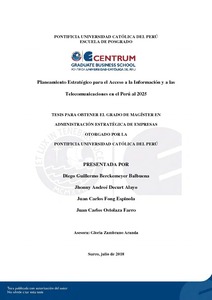| dc.contributor.advisor | Zambrano Aranda, Gloria María Regina | |
| dc.contributor.author | Berckemeyer Balbuena, Diego Guillermo | es_ES |
| dc.contributor.author | Decurt Alayo, Jhonny Andreé | es_ES |
| dc.contributor.author | Fong Espinola, Juan Carlos | es_ES |
| dc.contributor.author | Ostolaza Farro, Juan Carlos | es_ES |
| dc.date.accessioned | 2018-07-30T17:15:33Z | |
| dc.date.available | 2018-07-30T17:15:33Z | |
| dc.date.created | 2018 | |
| dc.date.issued | 2018-07-30 | |
| dc.identifier.uri | http://hdl.handle.net/20.500.12404/12351 | |
| dc.description.abstract | La presente tesis busca desarrollar el plan estratégico para el acceso a la información y
a las telecomunicaciones en el Perú al año 2025. El desarrollo del plan estratégico considera
el Modelo Secuencial del Proceso Estratégico, desarrollado por D’Alessio (2015) aplicado al
sexto pilar del Índice de Progreso Social desarrollado por la Institución Social Progress
Imperative. El sexto pilar denominado el acceso a la información y las telecomunicaciones
enfrenta desafíos de auto financiamiento para la ampliación de la red de cobertura móvil, de
la fibra ancha y sus servicios conexos tanto en la zona rural como urbana de baja densidad del
país.
El presente plan estratégico indicó que existe una alineación entre los objetivos de
desarrollo planteados en el sexto pilar y los objetivos impuestos por el Estado peruano al
bicentenario. Entre las principales tendencias que motivan la integración del Perú a la
información han sido identificadas: (a) El internet de las cosas, (b) la red 5G, (c) la migración
del comportamiento de conexión de internet por los usuarios de una conexión fija por una
conexión móvil, y (d) el beneficio en la productividad que representa el acceso a la
información para la nación. En ese sentido, se ha identificado que el Perú muestra un
desarrollo concentrado únicamente en sus urbes más pobladas y que el principal desafío se
identifica en el desarrollo de las zonas rurales y zonas urbanas de baja densidad.
Finalmente, cabe precisar que la expansión para el acceso a la información y las
telecomunicaciones en el Perú radica en la capacidad del Estado para identificar, promover y
subsidiar el desarrollo de la infraestructura primaria necesaria para promover la integración a
la era digital de más de 7 millones de peruanos, así como beneficiarlos de las ganancias de
productividad potencialmente obtenidas del mismo acceso a la información | es_ES |
| dc.description.abstract | This thesis seeks to develop the strategic plan for access to information and
telecommunications in Peru by 2025. The development of the strategic plan considers the
Sequential Model of the Strategic Process, developed by D'Alessio (2015) applied to the sixth
pillar of the Index of Social Progress developed by the Social Institution Progress Imperative.
The sixth pillar, called access to information and telecommunications, faces challenges of
self-financing for the expansion of the mobile coverage network, of broad fiber and its related
services in both the rural and low-density urban areas of the country.
This strategic plan indicated that there is an alignment between the development
objectives set out in the sixth pillar and the objectives imposed by the Peruvian state on the
bicentennial. Among the main trends that motivate the integration of Peru to information
have been identified: (a) internet de las cosas, (b) the 5G network, (c) the migration of
Internet connection behavior by users of a fixed connection by a mobile connection and (d)
the productivity benefit represented by access to information for the nation. In that sense, it
has been identified that Peru shows a concentrated development only in its most populated
cities and that the main challenge is identified in the development of rural areas and low
density urban areas.
Finally, it should be noted that the expansion for access to information and
telecommunications in Peru lies in the capacity of the State to identify, promote and subsidize
the development of the primary infrastructure necessary to promote the integration into the
digital era of more than 7 millions of Peruvians, as well as benefit them from the productivity
gains potentially obtained from the same access to information | es_ES |
| dc.language.iso | spa | es_ES |
| dc.publisher | Pontificia Universidad Católica del Perú | es_ES |
| dc.rights | Atribución-NoComercial-SinDerivadas 2.5 Perú | * |
| dc.rights | info:eu-repo/semantics/openAccess | es_ES |
| dc.rights.uri | http://creativecommons.org/licenses/by-nc-nd/2.5/pe/ | * |
| dc.subject | Acceso a la información -- Perú | es_ES |
| dc.subject | Telecomunicaciones -- Perú | es_ES |
| dc.subject | Planificación estratégica | es_ES |
| dc.title | Planeamiento estratégico para el acceso a la información y a las telecomunicaciones en el Perú al 2025 | es_ES |
| dc.type | info:eu-repo/semantics/masterThesis | es_ES |
| thesis.degree.name | Maestro en Administración Estratégica de Empresas | es_ES |
| thesis.degree.level | Maestría | es_ES |
| thesis.degree.grantor | Pontificia Universidad Católica del Perú. CENTRUM | es_ES |
| thesis.degree.discipline | Administración Estratégica de Empresas | es_ES |
| renati.discipline | 413307 | es_ES |
| renati.level | https://purl.org/pe-repo/renati/level#maestro | es_ES |
| renati.type | https://purl.org/pe-repo/renati/type#tesis | es_ES |
| dc.publisher.country | PE | es_ES |
| dc.subject.ocde | https://purl.org/pe-repo/ocde/ford#5.02.04 | es_ES |






